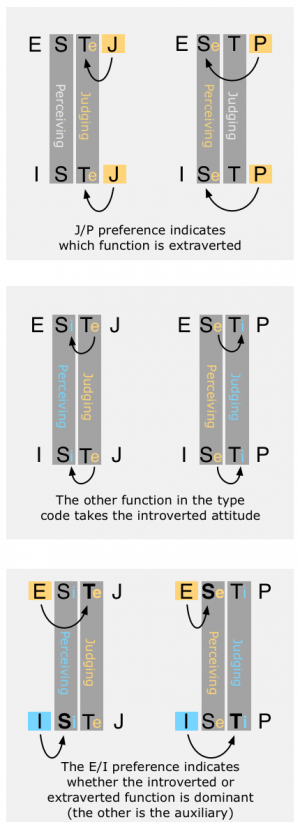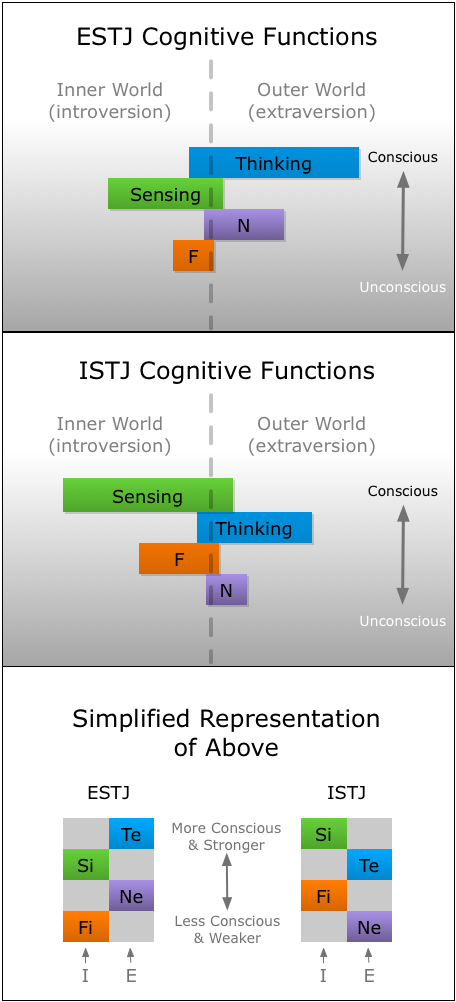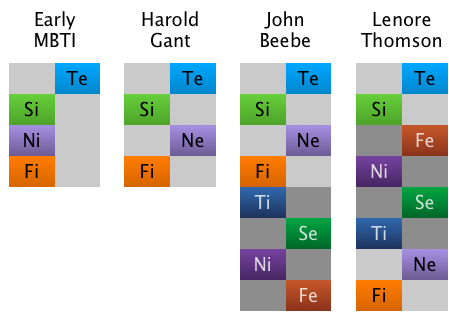Type Dynamics
Type Dynamics describe different models for describing typical ordering of Cognitive Functions for the various MBTI types. The cognitive functions (sometimes referred to as the Jungian Cognitive functions, or JCF) are preferred lenses through which we judge and perceive. Each cognitive function (referred to by Jung as "function attitude") is the combination of a function (Thinking, Feeling, Sensing, or iNtuiting) with an "attitude" (introversion or extraversion). This yields eight cognitive functions:
- Extraverted Thinking (Te)
- Introverted Thinking (Ti)
- Extraverted Feeling (Fe)
- Introverted Feeling (Fi)
- Extraverted Sensing (Se)
- Introverted Sensing (Si)
- Extraverted Intuition (Ne)
- Introverted Intuition (Ni)
Jung's Personality Types
Jung divided up the four functions into the rational functions (Thinking and Feeling) and the irrational functions (Sensation and Intuition). The rational functions are used for judging, while the irrational functions are used for perceiving.
Jung's Personality Types describes the eight JCF (function attitudes) in terms of sketches of individuals dominated by a particular function attitude.
Jung's Personality Types spends a significant amount of time describing each function attitude, but only makes a few, somewhat ambiguous statements about functions beyond the most preferred one for an individual. Jung generally referred to functions other than the dominant (primary) function as "inferior functions." Jung did make a reference to "auxiliary" function (p406):
Experience shows that the secondary function is always one whose nature is different from, thought not antagonistic to, the primary function. [...] Neither intuition nor sensation is antagonistic to thinking [...] but are functions of perception, affording welcome assistance to thought. [...] Hence the auxiliary function is possible and useful only in so far as it serves the dominant function, without making claim to the autonomy of its own principle.
So it follows that, in Jung's view, that if one's dominant function is rational (Thinking of Feeling), then one's auxiliary function is irrational(Sensing or Intuition). Personality Types also makes it clear that an extravert's primary function is extraverted, while an introvert's primary function attitude is introverted.
The auxiliary function has an attitude opposite of the primary function. So an ESTJ, for example, would have a Te dominant function and a Si auxiliary function.
What is not entirely clear, however, is the attitude (introverted or extraverted) of the tertiary cognitive function. Jung writes (p.340):
We call a mode of behavior extraverted only when the mechanism of extraversion predominates. In these cases the most differentiated function is always employed in an extraverted way, whereas the inferior functions are introverted; in other words, the superior function is the most conscious one and completely under the conscious control, whereas the less differentiated functions are in part unconscious and far less under the control of consciousness.
which seems to imply all the inferior (non-dominant) functions have the opposite attitude as the dominant function (for an ESTJ: Te Si Ni Fi). This differs from most modern models of type dynamic, which give the tertiary the some attitude as the dominant function (Te Si Ne Fi).
The MBTI
The Myer's Briggs Type Indicator (MBTI) is a written instrument for determining one's Jungian typological preference. The MBTI was developed by Katharine Cook Briggs and her daughter, Isabel Briggs Myers and was based on Jung's work. The two honed the MBTI and adjusted the Jungian definitions based on the data and analysis.
The MBTI represents type as a four letter type code, in which each letter of the type represents a dichotomy:
| Position | Dichotomy | Description |
|---|---|---|
| 1 | E/I | Represents Extraversion or Introversion. Those with a preference for Extraversion gain energy from external stimulation and interaction with others. Those with a preference for Introversion gain energy from being alone and being in a calm environment. This dichotomy is sometimes referred to as "attitude" or "orientation". |
| 2 | S/N | Representation Sensing or iNuition (N is used for intuition, since I is used for Introversion). Those with a preference for Sensing tend to notice the factual and the here and how. Those with a preference for Intuition tend to focus on concepts and the possibilities. This dichotomy represents the perceiving preference. |
| 3 | T/F | Thinking or Feeling. Those with a preference for Thinking prefer making decisions based on dispassionate and objective criteria. Those with a preference for Feeling prefer making decisions based on relationships and subjective criteria. This dichotomy represents the judging function. |
| 4 | J/P | Judging or Perceiving. Those with a preference for Judging prefer predictability and prefer to make decisions quickly (so things are settled). Those with a preference for Perceiving prefer to be open to whatever happens and prefer to postpone decision making in favor of gathering more information. This pole represents whether the judging or perception function is extraverted. |
From the type code, the dominant and auxiliary cognitive function (function attitude) can be determined (see sidebar).
Commonalities of Modern Type Dynamic Models
Most modern JCF models build on Jung's cognitive functions (JCF or "function attitudes"), and posit that the most preferred functions are the most consciously controlled, and the least preferred functions are the least consciously controlled. Most assume that individuals have access to the all four basic functions (Thinking, Feeling, Sensing, and iNtuition), but that each type has a scale of most preferred to least preferred JCF.
Most type dynamic models also describe type development models in which a type's most preferred functions develop first (where develop means a JCF is under conscious control and functions in an advanced and nuanced fashion), and then less preferred functions develop over time as the individual matures. Most models assumes that the least developed JCF develops last, with some models declaring that the least preferred JCF never develops consciously, so that it remains available to the unconscious.
Most type dynamic models share the common layout for the main four functions. They are:
| Order | Role | Function (for ESTJ) | Description |
|---|---|---|---|
| 1 | Dominant | Te | The dominant function is the function most aligned with the conscious. For extraverts, the dominant function is extraverted and tends to be the most visible. For introverts the dominant functions is introverted and may not be the most visible function. Being subjective, the dominant function may be less perceptible to oneself than the auxiliary function, because it is such an ingrained perspective. |
| 2 | Auxiliary | Si | The Auxiliary function balances and supports the dominant function. If the dominant function is Judging, the auxiliary function is Perceiving (and vice versa). The auxiliary function has the opposite attitude (extraversion/introversion) of the dominant function. |
| 3 | Tertiary | Ne (or Ni in older MBTI Manuals) | The tertiary function is the opposite of the auxiliary function (in Grant's model and most eight function models). The tertiary function carries a sense of being vulnerable, or finding "relief". |
| 4 | Inferior | Fi | The inferior function is the least conscious function, and is the opposite of the dominant function. The inferior function is often involved in "being in the grip" experiences. Some argue that the inferior function comes under conscious control later in life, while others argue it's important that the unconscious be able to express itself through the inferior function. |
The above can be displayed visually (using ESTJ and ISTJ as example) as:
For more information, see a complete set of function charts.
Four vs Eight Cognitive Functions
Some type dynamic models declare that there are only four functions, and each is developed in a single attitude (extraverted or introverted). Other models declare that each individual has all eight cognitive functions, and each has a order for each personality type.
Four Function Models
As mentioned above, the four function models posit that there are only four functions, and each is developed with a particular attitude (introversion/extraversion), The two best-known four function models are the models used in early versions of the MBTI manual (in which the attitude of the tertiary was opposite of the dominant function), and the Harold Grant module (in which the tertiary shares the attitude of the dominant functions).
Grant's model has become the standard four function model, and serves as the basis for the eight function models. For more information, see a complete table of Grant's model.
Eight Function Models
The eight function models posit that each individual has some access (conscious or unconscious) to all eight cognitive functions, and that there are standard orders of functions for each type.
The eight function models generally keep the relative order of the functions in Grant's model, but add the additional four functions.
John Beebe's Model
John Beebe's posits that the four other functions are less conscious than the inferior function, so occupy positions 4 through 8. In Beebe's model, functions 4-8 occur in the same order as functions 1-4, but with the opposite attitude. Beebe also assigns to each function position an archetype.
| Order | Function
(for ESTJ) |
Archetype |
|---|---|---|
| 1 (Dom) | Te | Hero |
| 2 (Aux) | Si | Good Parent |
| 3 (Ter) | Ne | Puer/ella |
| 4 (Inf) | Fi | Anima/us |
| 5 | Ti | Oppos. Persona |
| 6 | Se | Witch/Senex |
| 7 | Ni | Trickster |
| 8 | Fe | Demon/Daimon |
For more information, see a complete chart of Beebe's type dynamics for each type.
Lenore Thomson's Model
Lenore Thomson proposed a lesser know model in her book Personality Type: An Owner's Manual. In Thomson's model, the other four functions are inserted between the auxiliary and tertiary function (see graphic above). Lenore Thomson assigns some specific roles to these additional functions:
| Order | Function
(for ESTJ) |
|---|---|
| 1 (Dom) | Te |
| 2 (Aux) | Si |
| 3 (crow's nest 1) | Fe |
| 4 (crow's nest 2) | Ni |
| 5 (double agent 1) | Se |
| 6 (double agent 2) | Ti |
| 7 (Ter) | Ne |
| 8 (Inf) | Fi |
Thomson assigns the functions in slots three and four as the "crow's nest" functions, which provide alternative solutions with are most preferred approaches fail (p89). She assigns the functions in slots 5 and 6 as the "double agent" functions, which (when all else fails) commit mutiny to pull us towards our less conscious side.
In addition, Thomson assigns functions to quadrants of the brain:
| Front of Left Brain | Front of right Brain |
|---|---|
| Te | Ne |
| Fe |
Se |
| Si | Fi |
| Ni | Ti |
| Back of Left Brain | Back of Right Brain |
Hence an ESTJ's dominant function is a left brain function, so their "crow's nest" functions will be in the same hemisphere (and so known as "left brain alternatives" for an ESTJ). Conversely, the "double agent" functions are on the opposite hemisphere as the dominant function, so for an ESTJ their crow's nest functions would be "right brain" functions.


